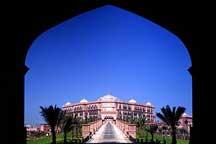 Apr. 11, 2025
Apr. 11, 2025
Weather
Self-drive tours becoming popular on Qinghai-Tibet Plateau
2009-09-29 17:31 BJT
BEIJING, Sept. 22 (Xinhuanet) -- "It‘s easier to travel overseas than to travel to Tibet" --this is what people often say while talking about the traffic conditions on the Qinghai-Tibet Plateau in the past.
However, in recent years, with the improvement of the living standard and transport services on the plateau, self-drive tours have been becoming increasingly popular.

A self-drive tourist poses with her car for a photo in front of the Potala Palace in Lhasa, southwest China‘s Tibet Autonomous Region in this undated file photo. (Xinhua Photo)
On the way from Xining, capital of northwest China‘s Qinghai Province, to Lhasa, capital of southwest China‘s Tibet, vehicles from different parts of China can be seen along the Qinghai Lake, Qarhan Salt Lake and the Hoh Xil Nature Reserve Area, known as the "forbidden area for life."
"I thought the roads here were going to be very rough and I was advised to bring two spare tyres with my jeep, " said Liu Xiaobo, who was on a self-drive tour to Tibet with his friends.
"But we have only changed one tyre so far and the road conditions are much better than I have imagined," said Liu while visiting the Soinam Targyai Protection Station of Hoh Xil.
The station, not far from the Qinghai-Tibet Railway and 4,500 m above the sea level, is an essential stop for self-drive tourists to Tibet. Every June and July, the station sees about 100 tourists traveling there by driving their own vehicles.

Self-drive tourists pose for photos at the Soinam Targyai Protection Station of the Hoh Xil Nature Reserve Area along the Qinghai-Tibet Road in this file photo. (Xinhua Photo)
"We had no means at all to come here 20 years ago," said Liu, who was working for a travel agency in north China‘s Tianjin. He drove to Tibet with his friends along the Sichuan-Tibet Road and is planning to return to Tianjin along the Qinghai-Tibet Road.
Liu still remembers vividly the time he led a tour to Tibet by air in 1986. At that time, the road connecting Lhasa to Xiageze was very rough, with rocks falling from mountains on the way from time to time. "We all had our hearts in our mouths while traveling along."
"Though conditions on some roads are still very poor now mainly because they are being maintained. On the Sichuan-Tibet Road, even one section of it is cut off by mud slides, travelers won‘t be detained for long as road maintenance workers will fix the problem in time, " Liu added.
Due to the unique geographical and climatic conditions, the transport services on the Qinghai-Tibet Plateau far lagged behind and few tourists could travel there. Moreover, most of the tours were exploratory in nature.

File photo shows Liuwu Overpass, which is the first overpass of Lhasa, capital of Tibet Autonomous Region. (Xinhua Photo)
According to a book published in the 1930s, people then travelled mainly on foot and goods were carried mostly by people and yaks or horses.
However, traffic conditions on the plateau began to improve in the 1950s. In December 1954, both the Qinghai-Tibet and Sichuan-Tibet roads opened to traffic. In May 1956, the air route from Beijing to Lhasa saw its first successful test flight. In July 2006, the Qinghai-Tibet Railway began operation. Meanwhile, Tibet has formed a network of quality roads extending to all corners.
While visiting the Soinam Targyai Protection Station, Liu and his friends gave out foods they had brought along with them to patrollers of the station.
"We bought the foods before we left for our tour, but we did not need them at all. In Lhasa, you can get whatever you want. Even in some smaller counties there are supermarkets of various scales, selling all kinds of goods, " Liu said.
Liu went to a supermarket in Bome County in southeastern Tibet especially. The home appliances at the supermarket cover not only various brands, but also the newest varieties -- much the same as those at supermarkets in Tianjin.
"There used to be a few restaurants and gas stations along the road. But now, it is easy to have meals and have your cars refueled. Moreover, there are even auto camps where self-drive travelers can stop and have a break, " Liu said. "The changes are so great."
"We passed by the Tonglha Moutains, Kunlun Mountains and numerous snowy mountains along our way. We saw not only the vast prairies and deserts, but also very rare wild animals. Our journey is full of surprises," said Liu‘s friend Xuan Fengpei. "The trip gave us the chance to appreciate the magnificence of our country."
"The journey is also like an expedition and I am going to promote self-drive tours among the travel agencies with my own experience. So more people can have the chance to enjoy the beautiful scenery of the region," said Liu.
Editor: 卢佳颖 | Source: Xinhuanet
 Mail
Mail Share
Share Print
Print


 Video
Video









 2009 China Central Television. All Rights Reserved
2009 China Central Television. All Rights Reserved